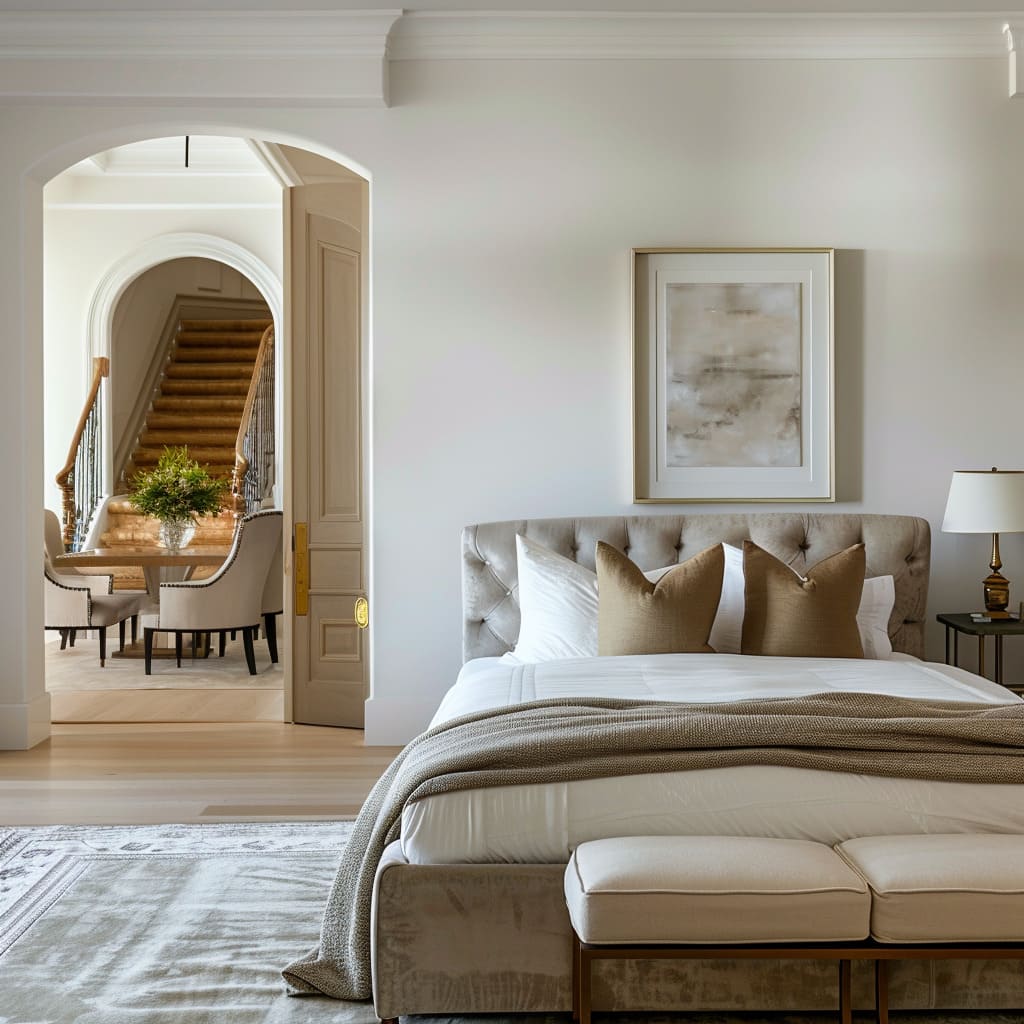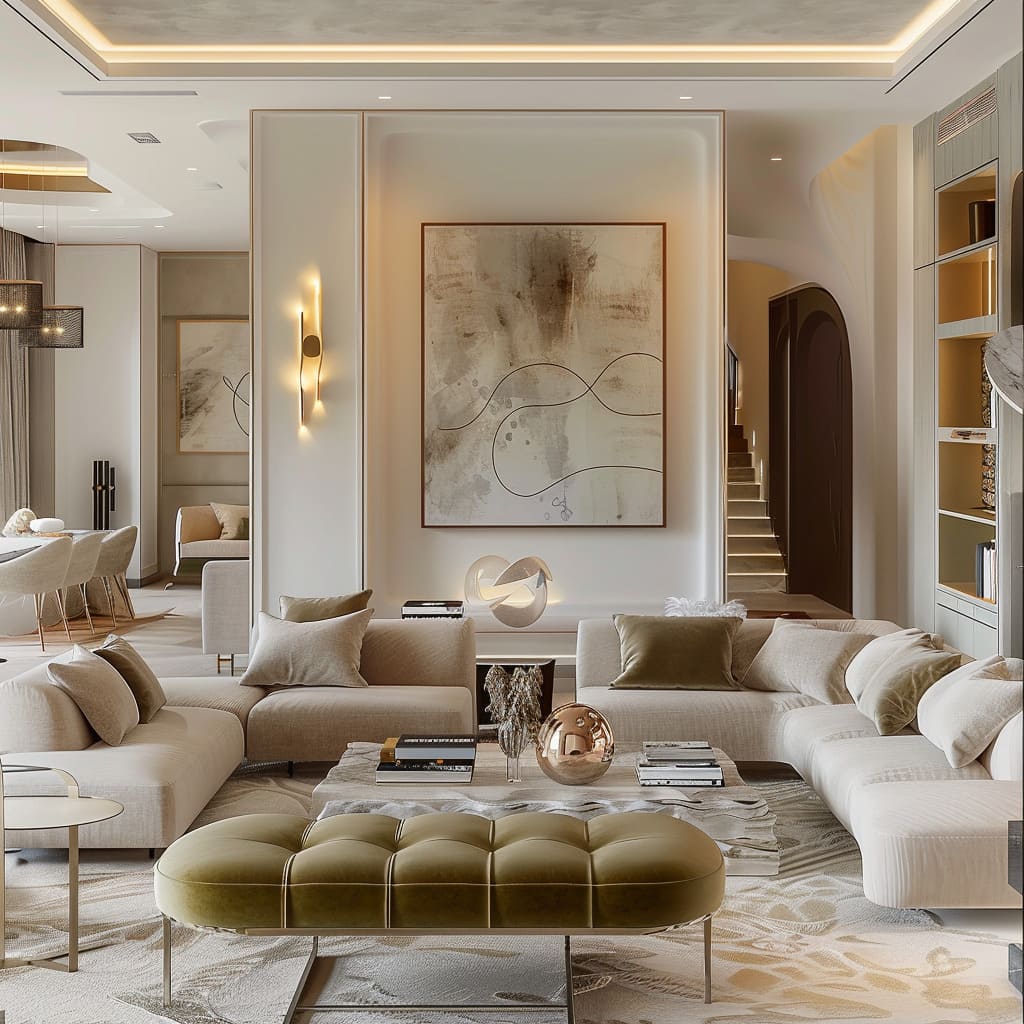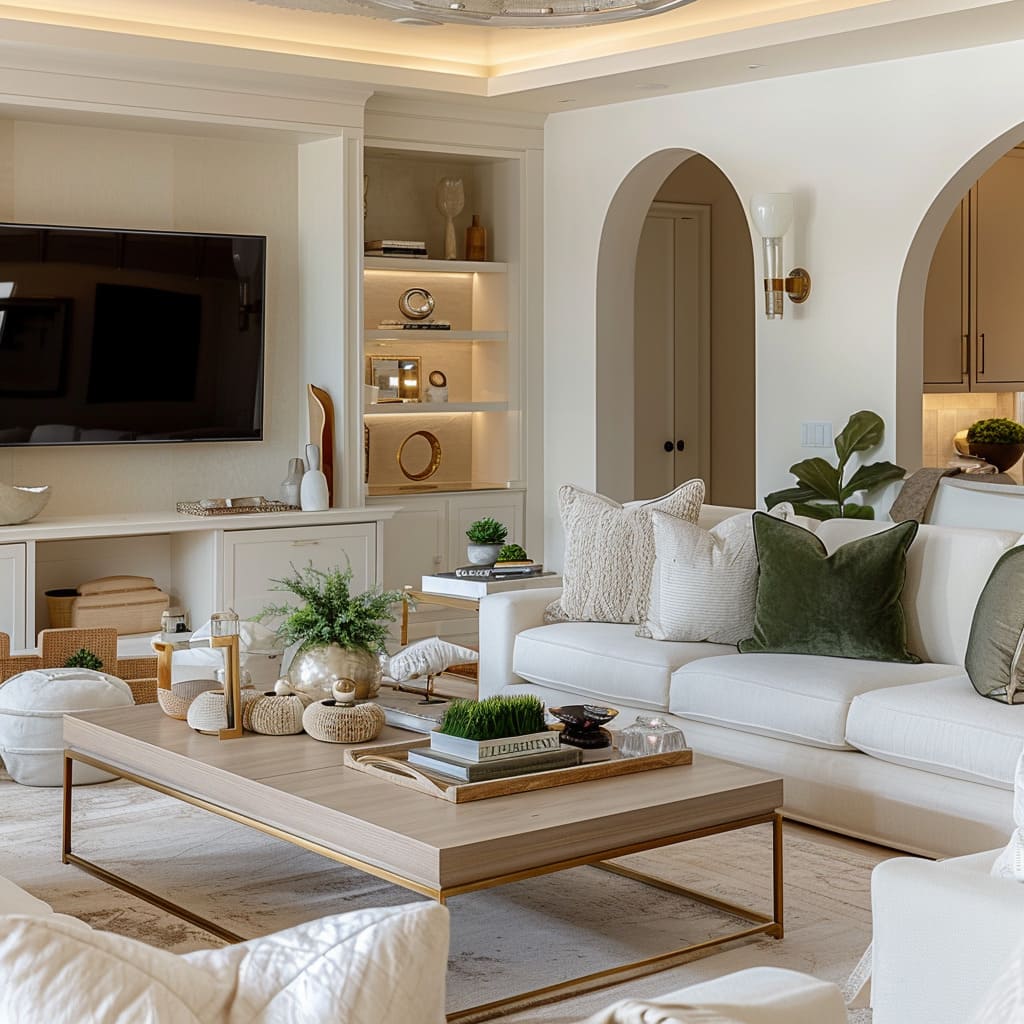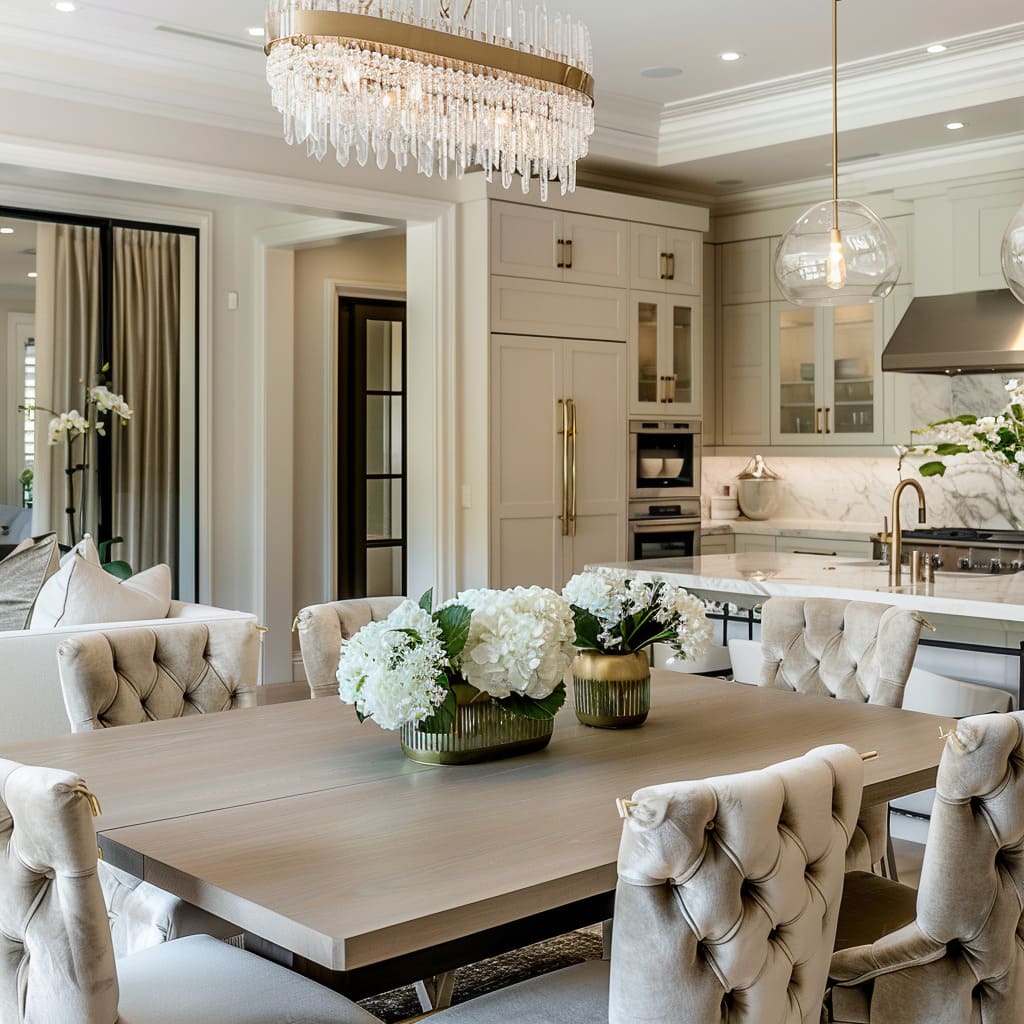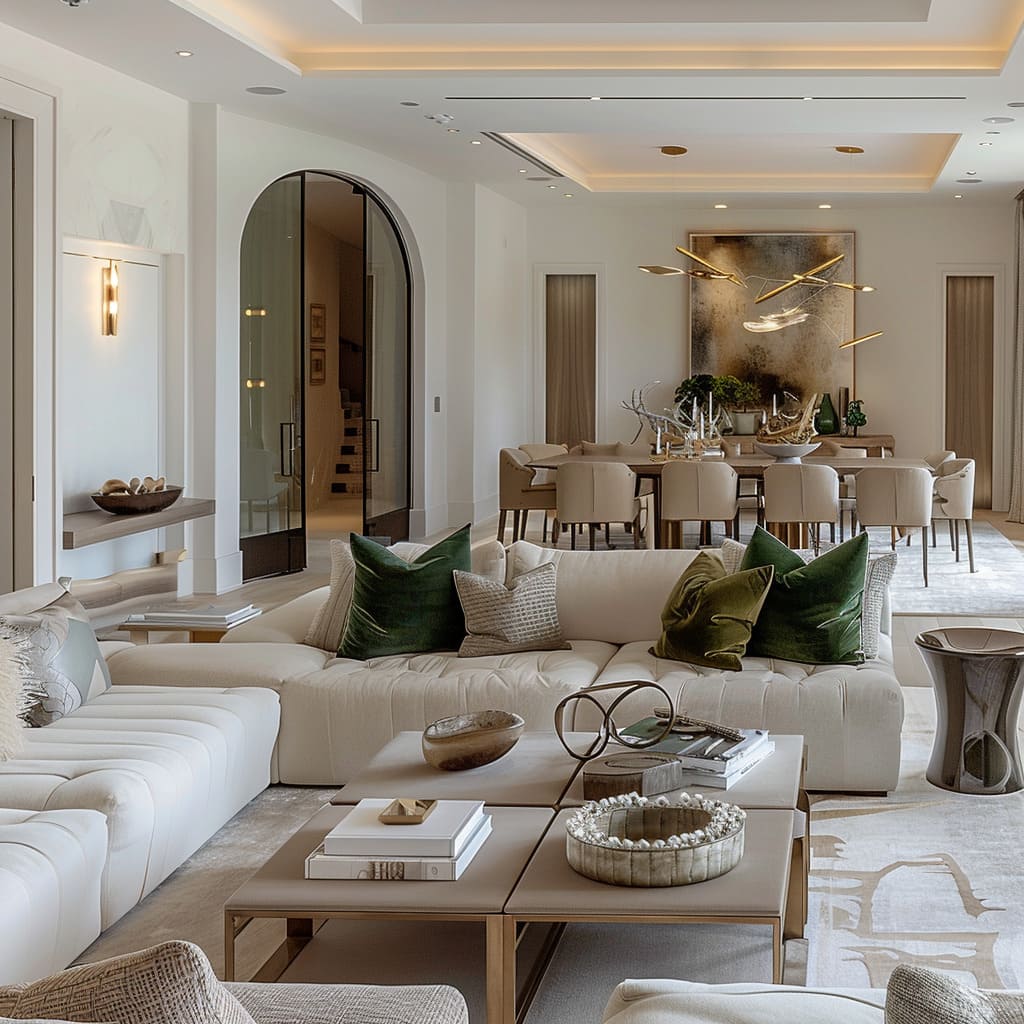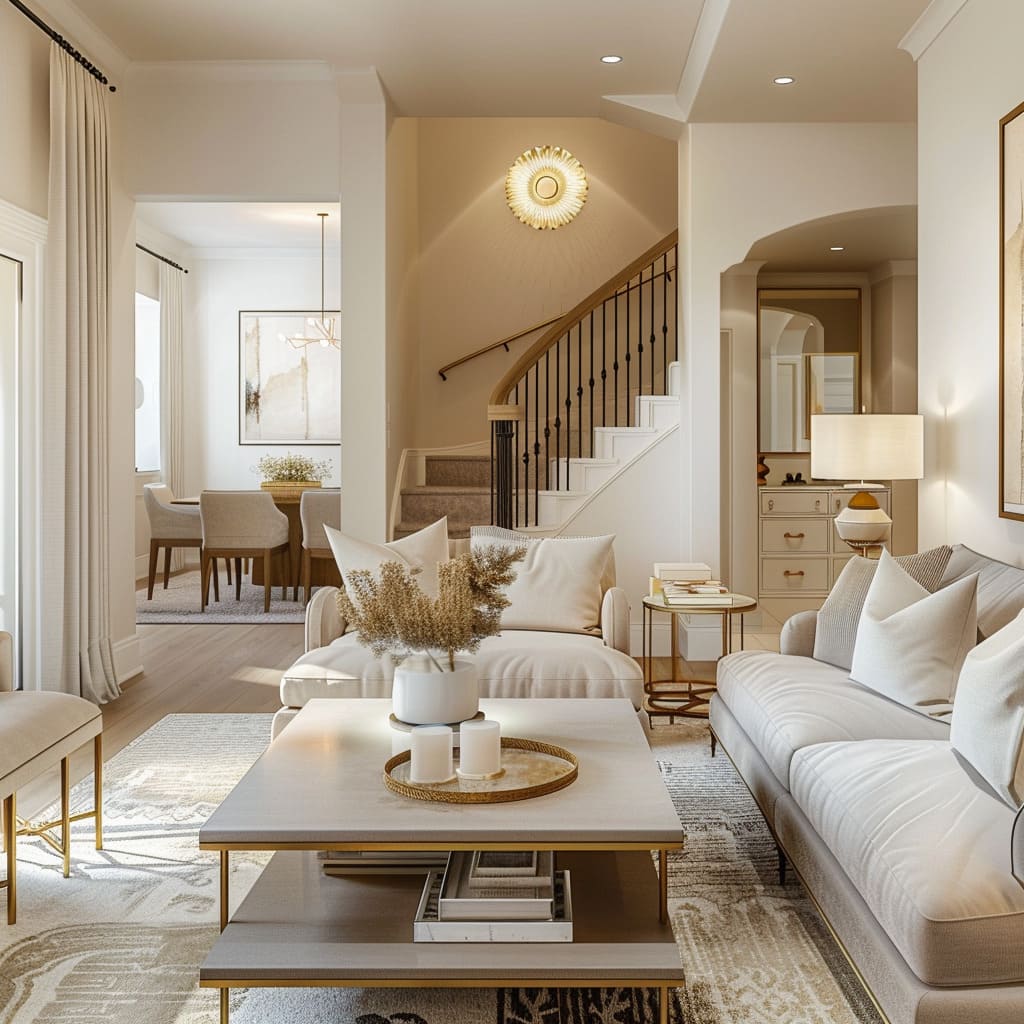Transitional design, a concept that strikes a balance between the welcoming warmth of traditional interiors and the sleek sophistication of modern styles, is the epitome of elegance with comfort. This style is an ideal choice for those who find beauty in both the classic and the contemporary.
In this article, we’ll explore the nuanced elements of Transitional design and offer practical advice on how to incorporate this aesthetic into your home.
At its core, Transitional design is about balance. It’s a thoughtful blend where ornate meets minimalistic, and where rich history pairs with clean innovation.
The challenge and the beauty lie in striking the right harmony between these elements to create a seamless flow from room to room. Inspiration for a Transitional space can come from a myriad of sources—a cherished heirloom, a piece of contemporary art, or even the architectural details of your home itself.
Start by identifying a central theme or piece that speaks to you and will serve as the focal point around which your design will revolve.
Color is a subtle yet powerful tool in defining the atmosphere of a room. Transitional design typically relies on a foundation of neutral shades—think ivories, beiges, and grays—that provide a backdrop for striking accent colors to pop.
These neutral tones create a canvas that allows textures and furnishings to stand out. Before embarking on your design journey, it’s crucial to establish a budget.
Begin by listing all the elements you want to include in your redesign, from paint to pillows. Allocate funds realistically, prioritizing investment pieces like sofas and beds, and don’t forget to set aside a contingency for unexpected expenses.
The key to achieving a high-end look without breaking the bank is to focus on strategic investments. Splurge on a few significant items, such as a comfortable couch or an elegant dining table, and save on accessories and accents.
Look for sales and discount stores or consider refurbished pieces. Lighting plays a critical role in Transitional design.
It’s not just about illuminating your space; it’s about setting the mood. Opt for a mix of overhead, accent, and task lighting to provide warmth and depth.
Dimmer switches can add versatility, altering the ambiance from bright and energetic to soft and serene.
When it comes to furniture, look for pieces that embody both comfort and clean lines. Your furnishings should be as inviting as they are stylish.
Seek out those with simple silhouettes upholstered in plush fabrics for a look that is both current and cozy. The arrangement of furniture should invite conversation and flow.
Avoid overcrowding a room; instead, opt for fewer pieces that can make a statement. Transitional design favors open space and clean organization, so leave breathing room around your furniture to achieve a balanced look.
Texture and material are the secret ingredients that add interest and depth to a Transitional space. Combine glass with metal, or wood with leather, to create tactile and visual variety.
Throw in a mix of smooth and nubby textiles to further the appeal. Finally, art and wall decor will give your home a personal touch.
Choose pieces that resonate with your theme and enhance the color scheme. Remember, in a Transitional design, less is often more, so let each piece stand out rather than crowding your walls.
As we move through these foundational elements of Transitional design, we’ll delve deeper into practical tips and detailed strategies to help you create a space that’s both inviting and on-trend, all while adhering to a budget that works for you. Stay tuned as we continue to unwrap the layers of this adaptable and enduring style.
Artwork and wall décor have the remarkable ability to complete a room, but they needn’t come with a hefty price tag to match their visual impact. To complement the Transitional aesthetic, select pieces that add a dash of color or modernity, yet don’t dominate the space.
Consider local art fairs, online marketplaces, or even creating your own art. Think large-scale canvases with abstract designs or classic prints that tie in your accent colors—all of which can achieve a high-end look without overspending.
When it comes to window treatments, they serve as more than just decorative elements; they offer privacy and can affect the room’s lighting and temperature. In Transitional design, window treatments should blend with the wall color for a seamless look, perhaps adding a touch of luxury with textural weaves or understated patterns.
Opt for lined curtains to enhance insulation and blackout options in bedrooms for better sleep quality. Rugs can ground a room’s design and are a great way to add warmth and texture.
In Transitional interiors, choose a rug that complements the neutral palette but don’t be afraid of introducing a geometric or floral pattern for added interest. Placement is key—ensure your rug is proportional to your furniture arrangement and leave consistent floor space around the rug’s edge to frame your design.
Accent pieces like cushions, vases, and books are the finishing touches that make a space feel lived-in and complete. Hunt for bargains at thrift stores or choose from a range of affordable retailers.
These elements should echo the room’s color scheme and theme but can also introduce a pop of color or an interesting shape or texture. Greenery is an often-overlooked element that can bring vitality to any room.
Plants not only add color and life but also improve air quality. In Transitional spaces, consider sleek pots that fit the color palette, with plants that require varying levels of sunlight, which will allow you to place them in different areas throughout the room.
Open and negative space is crucial in Transitional design. It’s about the art of restraint, not filling every nook and cranny.
Instead of a room full of furniture, opt for key pieces that speak to both function and form, leaving open space that allows the room to breathe and the design to shine through. Negative space should be balanced—it should feel intentional, not as if something is missing.
Mirrors can play a magical role in your design by reflecting light and views, making rooms feel larger and more open. In a Transitional home, choose mirrors with simple frames that complement the room’s metal finishes or wood tones, and place them strategically to catch light or highlight a particular view or artwork.
Lastly, DIY decor offers a personalized touch that can also be gentle on the wallet. Whether it’s repainting an old chair, crafting your own lampshade, or creating a gallery wall of family photos, these projects not only save money but also allow for a custom look that’s unique to your home.
It’s about embracing the imperfect and homemade, which often adds more character than anything store-bought could offer. Flooring sets the stage for any interior design scheme, and in Transitional style, it should complement both the classic and modern elements.
When budget is a consideration, laminate and luxury vinyl tile present cost-effective alternatives that can mimic the look of hardwood or stone. Engineered wood is another option that offers the warmth and appearance of solid wood but at a more affordable price point.
Whichever material you choose, aim for a color and texture that lends a cohesive look to your space without overshadowing other design elements.
Intelligent storage solutions are key to maintaining the clean lines and uncluttered spaces that are signature to Transitional design. Consider built-in units for a custom look, use furniture with hidden storage, or invest in attractive baskets and boxes that can double as decor.
Well-planned storage not only keeps clutter out of sight but also contributes to the room’s overall aesthetic, reinforcing the design’s blend of functionality and style. Harmonizing different design elements is essential to a successful Transitional space.
It’s about creating a dialogue between the old and new, where each piece relates to the other in scale, style, or color. An heirloom table might be paired with contemporary chairs, or antique lamps with a modern sofa.
The key is to select items that share an underlying commonality, whether it’s the finish, material, or silhouette, to achieve a cohesive and intentional design.
A mood board is an invaluable tool in the design process, allowing you to visualize and refine your ideas. Start by gathering samples of your materials, paints, fabrics, and pictures of furniture.
Arrange these on a large board or digital platform, experimenting with different layouts until you find the perfect mix. This collage will guide your decisions and help ensure your room’s elements work in harmony.
Space limitations often call for creative design solutions. In smaller spaces, choose furniture that doesn’t overpower—think a loveseat instead of a sprawling sofa, or a round table to facilitate flow.
For awkwardly shaped rooms, custom pieces or multifunctional furniture can maximize utility without sacrificing style. Mirrors, as mentioned earlier, can also play a role in making spaces feel larger and more open.
Incorporating modern technology without disturbing the Transitional aesthetic requires a deft touch. Hide tech elements within cabinetry or behind artworks that lift or slide away.
Choose sleek, unobtrusive designs for speakers, TVs, and other devices, and look for ways to integrate smart home controls seamlessly into your living spaces, such as disguised outlets or recessed lighting.
Transitional design can effortlessly adapt to different seasons through the use of textiles and accessories. Lightweight linen throw pillows and sheer curtains can lend a breezy, summery feel, while plush throws and heavier drapes can warm up a room for winter.
Choose versatile foundational pieces, and switch out accents as the seasons change. Material durability is an important consideration, especially when adhering to a budget.
Look for high-quality, wear-resistant fabrics for upholstery, and choose solid wood or metal for furniture to ensure longevity. While such materials might come with a higher initial cost, their durability will save money in the long run as they withstand the test of time and use.
Color theory is fundamental to achieving balance and harmony in Transitional interiors. A muted palette with strategic pops of color can define and elevate the entire design scheme.
Use complementary colors for accents and analogous colors for a more serene setting, always considering the psychological impact of each hue to create the desired ambiance. Finally, leveraging online design tools can streamline the entire design process.
From virtual room planners to color scheme generators, these resources allow you to experiment with different layouts and palettes before making any physical changes. They’re a cost-effective way to plan and can often provide a new perspective on the potential of your space.
With these tools, you can refine your vision and ensure every choice contributes to the elegant Transitional home you aspire to create.
Discovering treasures in unconventional places is part of the joy of personalizing your Transitional space. Second-hand stores, flea markets, and estate sales can be gold mines for unique pieces with character that speak to both the traditional and contemporary sides of the style.
An antique lamp or an eclectic piece of art can become a conversation starter, adding depth and history to your home. Deciding whether to seek professional advice or embark on a self-design project can be challenging.
Consider consulting with a professional when structural changes are involved or when you’re stuck in a creative rut. For smaller updates or if you have a clear vision, trusting your instincts can lead to a deeply personal and satisfying outcome.
Professionals can provide a roadmap, but your journey through design is yours to travel.
Maintenance should be a top priority in any home, especially in one with a timeless design like the Transitional style. Opt for materials and finishes that are durable and easy to clean, such as quartz countertops, stain-resistant fabrics, and semi-gloss paint finishes.
These choices will help keep your home looking fresh and are practical for everyday living.
Sustainability is increasingly important in interior design. Incorporate eco-friendly practices by choosing renewable materials like bamboo flooring or recycled glass countertops.
Select paints with low or no volatile organic compounds (VOCs), and consider energy-efficient appliances that save on costs while reducing environmental impact. Textiles are the soft touches that add comfort and luxury to a room.
In a Transitional space, layering different textiles can contribute to the overall feel and aesthetic. Use a mix of linen, cotton, wool, and velvet to provide a tactile experience that invites relaxation and comfort while remaining stylish and sophisticated.
Lighting fixtures serve a dual purpose in Transitional design; they illuminate the space while also serving as sculptural art pieces. A dramatic chandelier or a series of modern pendants can act as focal points, elevating the room’s style.
Choose lighting that complements the room’s architecture and furniture, ensuring it stands out without overwhelming the space. Scale and proportion are the unsung heroes of design, crucial in achieving balance in a Transitional space.
Furniture and decor should be sized appropriately for the room—larger rooms can handle grander pieces, while smaller spaces require more measured choices. Keeping a room proportionally balanced creates a sense of order and calm, integral to the Transitional style.
Trends can be tempting to follow, but when it comes to Transitional design, it’s best to navigate them wisely. Instead of overhauling your space with every new trend, incorporate small, easily changeable elements like throw pillows, accent colors, or decorative accessories.
This approach keeps your space current yet timeless.
The final touches, like the careful placement of a stack of books or the selection of cabinet hardware, are what complete a design. These details may seem minor, but they contribute significantly to the finished look, imbuing the space with personality and style.
It’s these thoughtful details that ensure your space is not only designed but curated. Taking a moment to review and reflect on your space before finalizing your design project is essential.
Step back and assess each room from various angles and at different times of the day. This perspective allows you to make final adjustments, ensuring that every element coexists harmoniously, and your Transitional design vision is fully realized.









